BUSN20016 Research: Leadership Strategies for Org Performance in AU
VerifiedAdded on 2023/06/14
|6
|1208
|405
Project
AI Summary
This research project outline aims to assess the impact of leadership on employee performance and overall organizational success in Australia, addressing concerns about slowing economic growth, weakening employment, and high attrition rates. It focuses on determining the impact of leadership on employee motivation and retention, examining the importance of transformational and transactional leadership styles, and developing effective strategies for Australian organizations. A mixed methodology approach, involving both quantitative (surveys and questionnaires) and qualitative (literature review and open-ended interviews with managers) data collection methods, will be employed. Probability sampling will be used to select five organizations for the study, with data analyzed using Microsoft Excel and presented in bar charts. The project seeks to provide insights into enhancing employee loyalty and improving organizational productivity through effective leadership strategies.
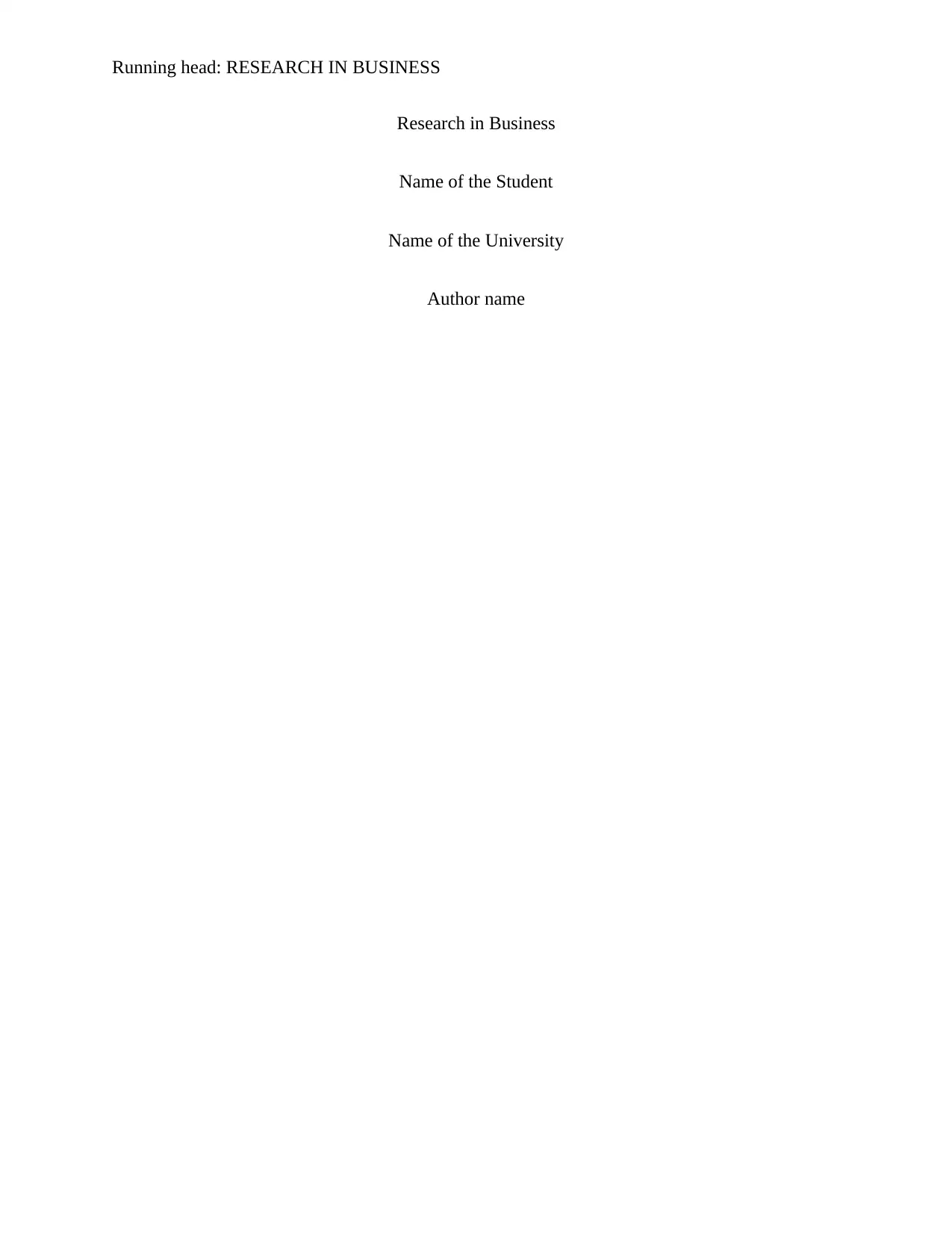
Running head: RESEARCH IN BUSINESS
Research in Business
Name of the Student
Name of the University
Author name
Research in Business
Name of the Student
Name of the University
Author name
Paraphrase This Document
Need a fresh take? Get an instant paraphrase of this document with our AI Paraphraser
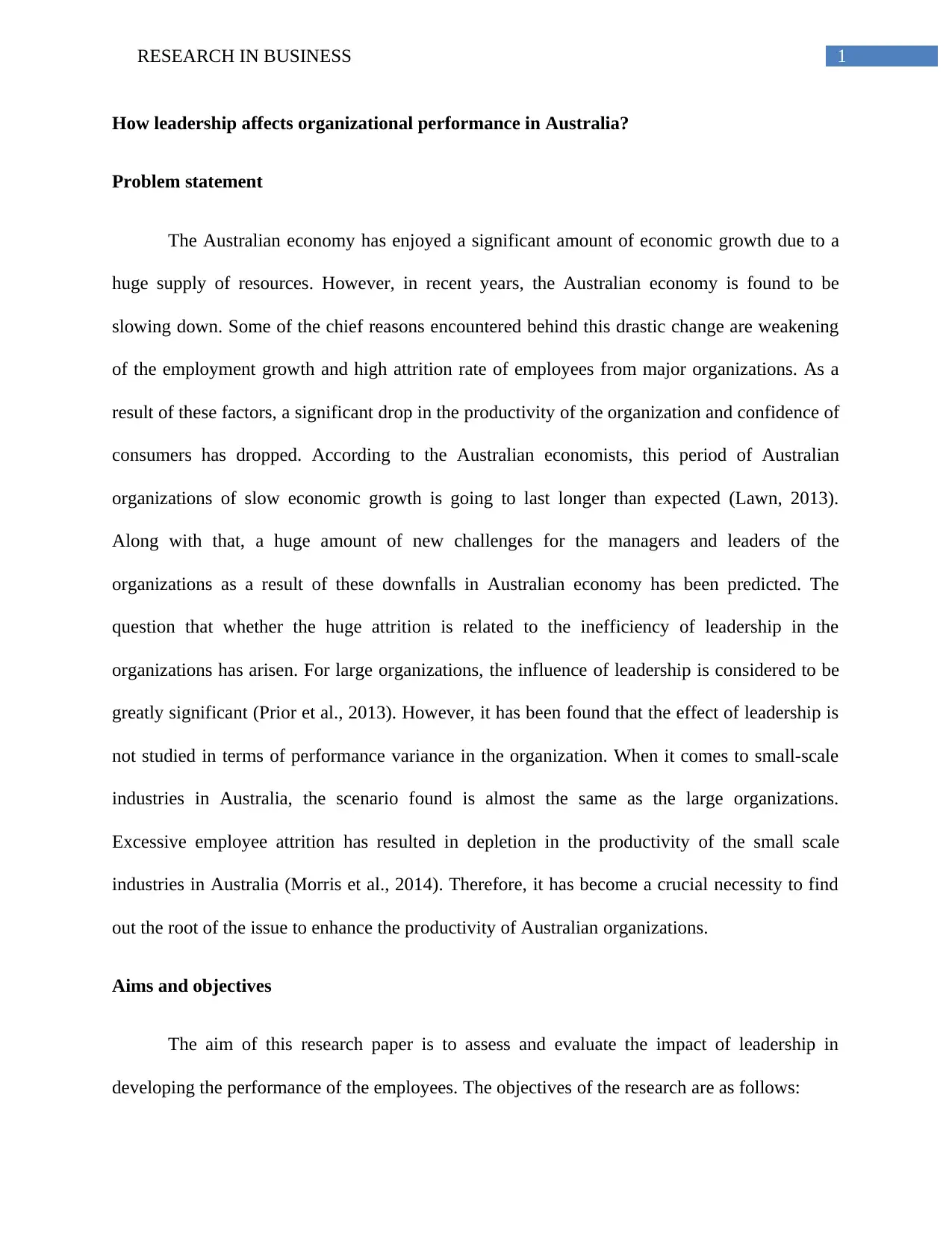
1RESEARCH IN BUSINESS
How leadership affects organizational performance in Australia?
Problem statement
The Australian economy has enjoyed a significant amount of economic growth due to a
huge supply of resources. However, in recent years, the Australian economy is found to be
slowing down. Some of the chief reasons encountered behind this drastic change are weakening
of the employment growth and high attrition rate of employees from major organizations. As a
result of these factors, a significant drop in the productivity of the organization and confidence of
consumers has dropped. According to the Australian economists, this period of Australian
organizations of slow economic growth is going to last longer than expected (Lawn, 2013).
Along with that, a huge amount of new challenges for the managers and leaders of the
organizations as a result of these downfalls in Australian economy has been predicted. The
question that whether the huge attrition is related to the inefficiency of leadership in the
organizations has arisen. For large organizations, the influence of leadership is considered to be
greatly significant (Prior et al., 2013). However, it has been found that the effect of leadership is
not studied in terms of performance variance in the organization. When it comes to small-scale
industries in Australia, the scenario found is almost the same as the large organizations.
Excessive employee attrition has resulted in depletion in the productivity of the small scale
industries in Australia (Morris et al., 2014). Therefore, it has become a crucial necessity to find
out the root of the issue to enhance the productivity of Australian organizations.
Aims and objectives
The aim of this research paper is to assess and evaluate the impact of leadership in
developing the performance of the employees. The objectives of the research are as follows:
How leadership affects organizational performance in Australia?
Problem statement
The Australian economy has enjoyed a significant amount of economic growth due to a
huge supply of resources. However, in recent years, the Australian economy is found to be
slowing down. Some of the chief reasons encountered behind this drastic change are weakening
of the employment growth and high attrition rate of employees from major organizations. As a
result of these factors, a significant drop in the productivity of the organization and confidence of
consumers has dropped. According to the Australian economists, this period of Australian
organizations of slow economic growth is going to last longer than expected (Lawn, 2013).
Along with that, a huge amount of new challenges for the managers and leaders of the
organizations as a result of these downfalls in Australian economy has been predicted. The
question that whether the huge attrition is related to the inefficiency of leadership in the
organizations has arisen. For large organizations, the influence of leadership is considered to be
greatly significant (Prior et al., 2013). However, it has been found that the effect of leadership is
not studied in terms of performance variance in the organization. When it comes to small-scale
industries in Australia, the scenario found is almost the same as the large organizations.
Excessive employee attrition has resulted in depletion in the productivity of the small scale
industries in Australia (Morris et al., 2014). Therefore, it has become a crucial necessity to find
out the root of the issue to enhance the productivity of Australian organizations.
Aims and objectives
The aim of this research paper is to assess and evaluate the impact of leadership in
developing the performance of the employees. The objectives of the research are as follows:
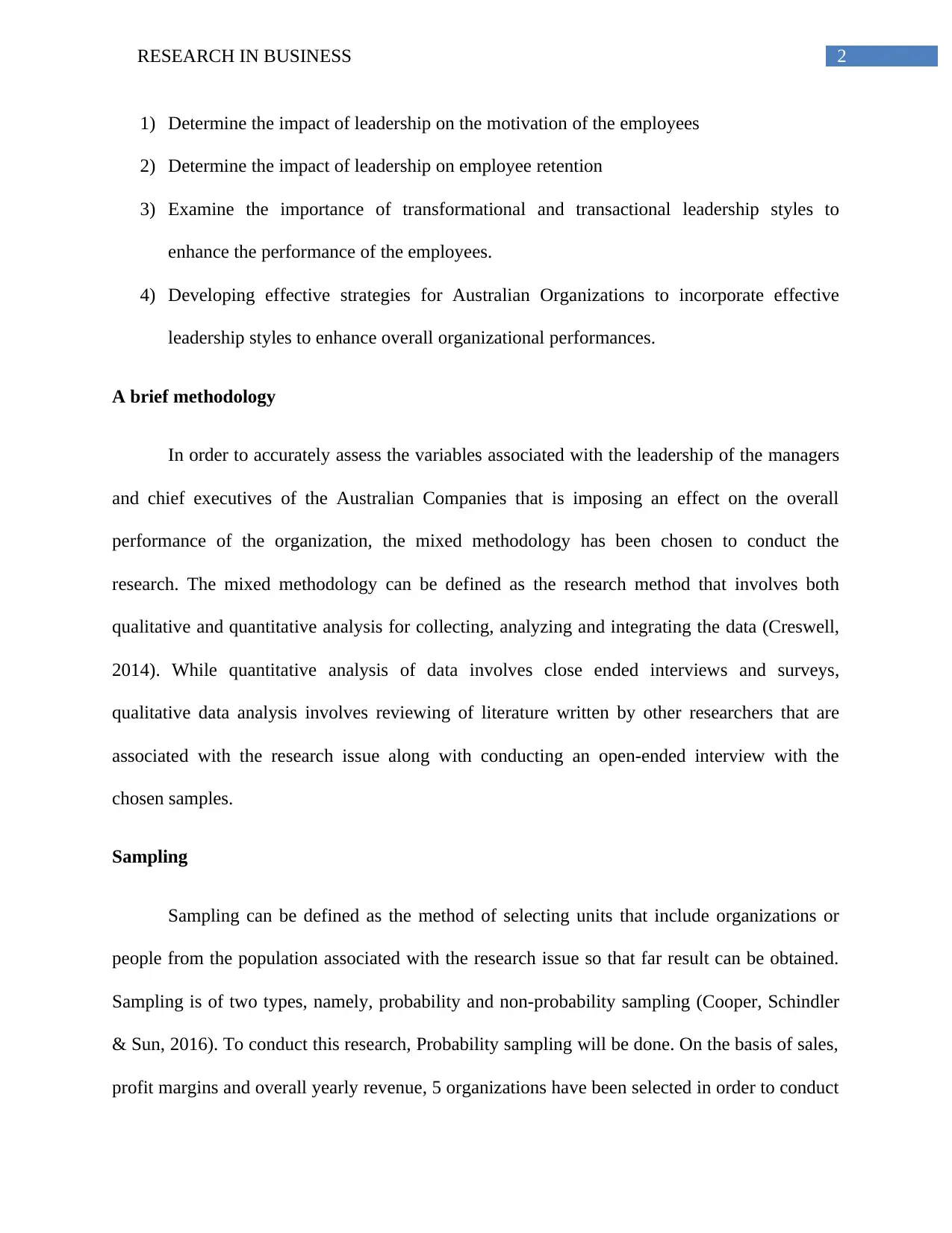
2RESEARCH IN BUSINESS
1) Determine the impact of leadership on the motivation of the employees
2) Determine the impact of leadership on employee retention
3) Examine the importance of transformational and transactional leadership styles to
enhance the performance of the employees.
4) Developing effective strategies for Australian Organizations to incorporate effective
leadership styles to enhance overall organizational performances.
A brief methodology
In order to accurately assess the variables associated with the leadership of the managers
and chief executives of the Australian Companies that is imposing an effect on the overall
performance of the organization, the mixed methodology has been chosen to conduct the
research. The mixed methodology can be defined as the research method that involves both
qualitative and quantitative analysis for collecting, analyzing and integrating the data (Creswell,
2014). While quantitative analysis of data involves close ended interviews and surveys,
qualitative data analysis involves reviewing of literature written by other researchers that are
associated with the research issue along with conducting an open-ended interview with the
chosen samples.
Sampling
Sampling can be defined as the method of selecting units that include organizations or
people from the population associated with the research issue so that far result can be obtained.
Sampling is of two types, namely, probability and non-probability sampling (Cooper, Schindler
& Sun, 2016). To conduct this research, Probability sampling will be done. On the basis of sales,
profit margins and overall yearly revenue, 5 organizations have been selected in order to conduct
1) Determine the impact of leadership on the motivation of the employees
2) Determine the impact of leadership on employee retention
3) Examine the importance of transformational and transactional leadership styles to
enhance the performance of the employees.
4) Developing effective strategies for Australian Organizations to incorporate effective
leadership styles to enhance overall organizational performances.
A brief methodology
In order to accurately assess the variables associated with the leadership of the managers
and chief executives of the Australian Companies that is imposing an effect on the overall
performance of the organization, the mixed methodology has been chosen to conduct the
research. The mixed methodology can be defined as the research method that involves both
qualitative and quantitative analysis for collecting, analyzing and integrating the data (Creswell,
2014). While quantitative analysis of data involves close ended interviews and surveys,
qualitative data analysis involves reviewing of literature written by other researchers that are
associated with the research issue along with conducting an open-ended interview with the
chosen samples.
Sampling
Sampling can be defined as the method of selecting units that include organizations or
people from the population associated with the research issue so that far result can be obtained.
Sampling is of two types, namely, probability and non-probability sampling (Cooper, Schindler
& Sun, 2016). To conduct this research, Probability sampling will be done. On the basis of sales,
profit margins and overall yearly revenue, 5 organizations have been selected in order to conduct
⊘ This is a preview!⊘
Do you want full access?
Subscribe today to unlock all pages.

Trusted by 1+ million students worldwide
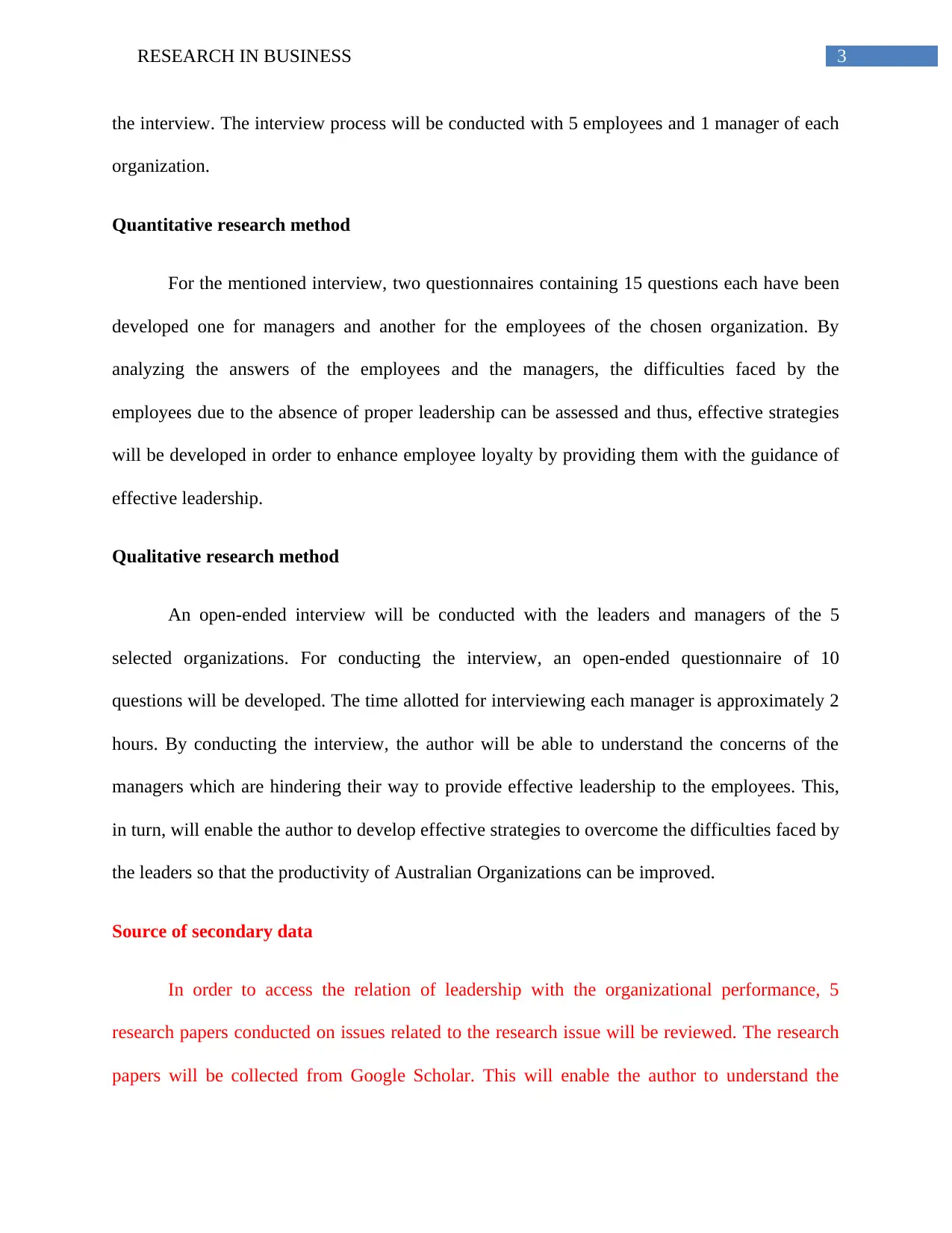
3RESEARCH IN BUSINESS
the interview. The interview process will be conducted with 5 employees and 1 manager of each
organization.
Quantitative research method
For the mentioned interview, two questionnaires containing 15 questions each have been
developed one for managers and another for the employees of the chosen organization. By
analyzing the answers of the employees and the managers, the difficulties faced by the
employees due to the absence of proper leadership can be assessed and thus, effective strategies
will be developed in order to enhance employee loyalty by providing them with the guidance of
effective leadership.
Qualitative research method
An open-ended interview will be conducted with the leaders and managers of the 5
selected organizations. For conducting the interview, an open-ended questionnaire of 10
questions will be developed. The time allotted for interviewing each manager is approximately 2
hours. By conducting the interview, the author will be able to understand the concerns of the
managers which are hindering their way to provide effective leadership to the employees. This,
in turn, will enable the author to develop effective strategies to overcome the difficulties faced by
the leaders so that the productivity of Australian Organizations can be improved.
Source of secondary data
In order to access the relation of leadership with the organizational performance, 5
research papers conducted on issues related to the research issue will be reviewed. The research
papers will be collected from Google Scholar. This will enable the author to understand the
the interview. The interview process will be conducted with 5 employees and 1 manager of each
organization.
Quantitative research method
For the mentioned interview, two questionnaires containing 15 questions each have been
developed one for managers and another for the employees of the chosen organization. By
analyzing the answers of the employees and the managers, the difficulties faced by the
employees due to the absence of proper leadership can be assessed and thus, effective strategies
will be developed in order to enhance employee loyalty by providing them with the guidance of
effective leadership.
Qualitative research method
An open-ended interview will be conducted with the leaders and managers of the 5
selected organizations. For conducting the interview, an open-ended questionnaire of 10
questions will be developed. The time allotted for interviewing each manager is approximately 2
hours. By conducting the interview, the author will be able to understand the concerns of the
managers which are hindering their way to provide effective leadership to the employees. This,
in turn, will enable the author to develop effective strategies to overcome the difficulties faced by
the leaders so that the productivity of Australian Organizations can be improved.
Source of secondary data
In order to access the relation of leadership with the organizational performance, 5
research papers conducted on issues related to the research issue will be reviewed. The research
papers will be collected from Google Scholar. This will enable the author to understand the
Paraphrase This Document
Need a fresh take? Get an instant paraphrase of this document with our AI Paraphraser
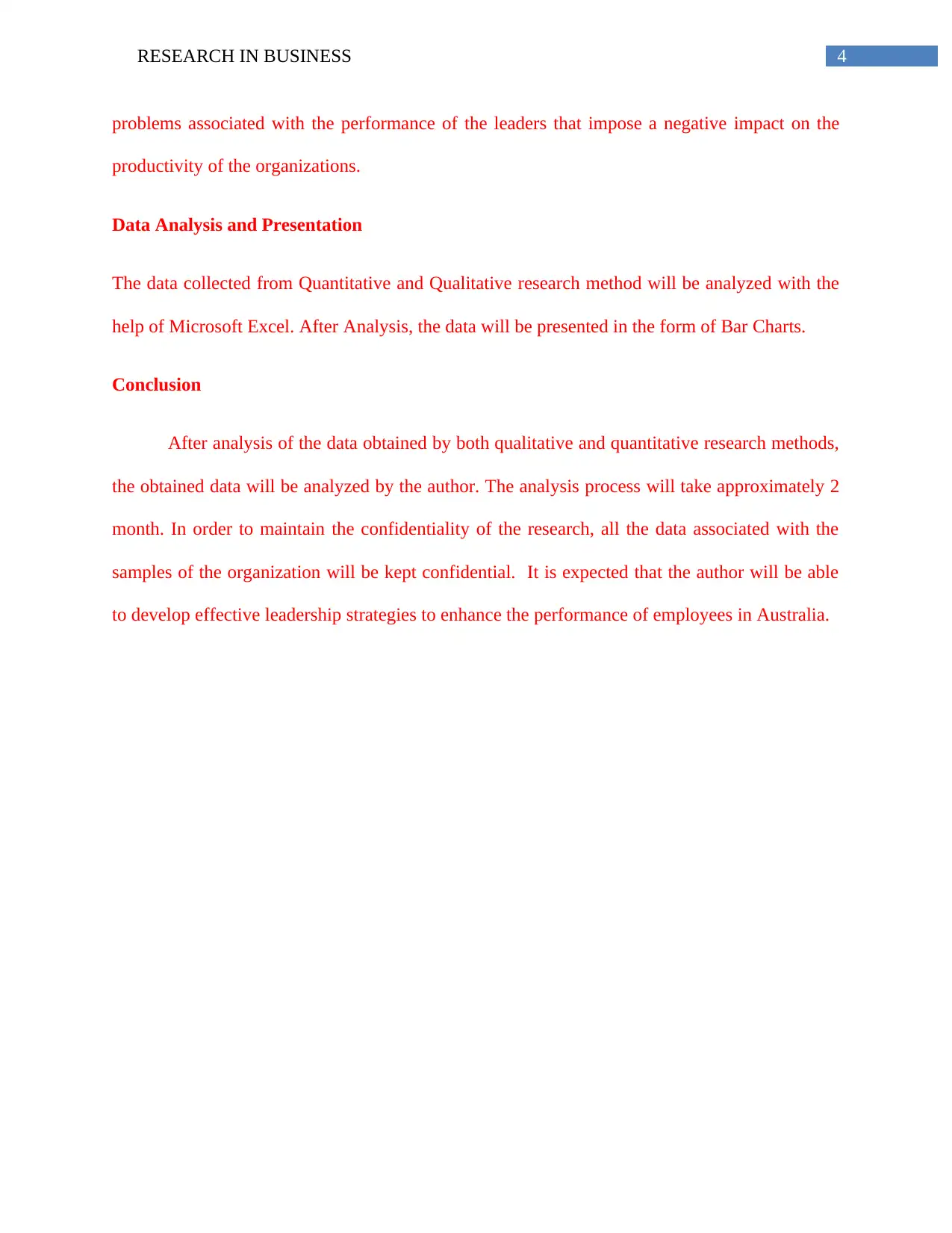
4RESEARCH IN BUSINESS
problems associated with the performance of the leaders that impose a negative impact on the
productivity of the organizations.
Data Analysis and Presentation
The data collected from Quantitative and Qualitative research method will be analyzed with the
help of Microsoft Excel. After Analysis, the data will be presented in the form of Bar Charts.
Conclusion
After analysis of the data obtained by both qualitative and quantitative research methods,
the obtained data will be analyzed by the author. The analysis process will take approximately 2
month. In order to maintain the confidentiality of the research, all the data associated with the
samples of the organization will be kept confidential. It is expected that the author will be able
to develop effective leadership strategies to enhance the performance of employees in Australia.
problems associated with the performance of the leaders that impose a negative impact on the
productivity of the organizations.
Data Analysis and Presentation
The data collected from Quantitative and Qualitative research method will be analyzed with the
help of Microsoft Excel. After Analysis, the data will be presented in the form of Bar Charts.
Conclusion
After analysis of the data obtained by both qualitative and quantitative research methods,
the obtained data will be analyzed by the author. The analysis process will take approximately 2
month. In order to maintain the confidentiality of the research, all the data associated with the
samples of the organization will be kept confidential. It is expected that the author will be able
to develop effective leadership strategies to enhance the performance of employees in Australia.
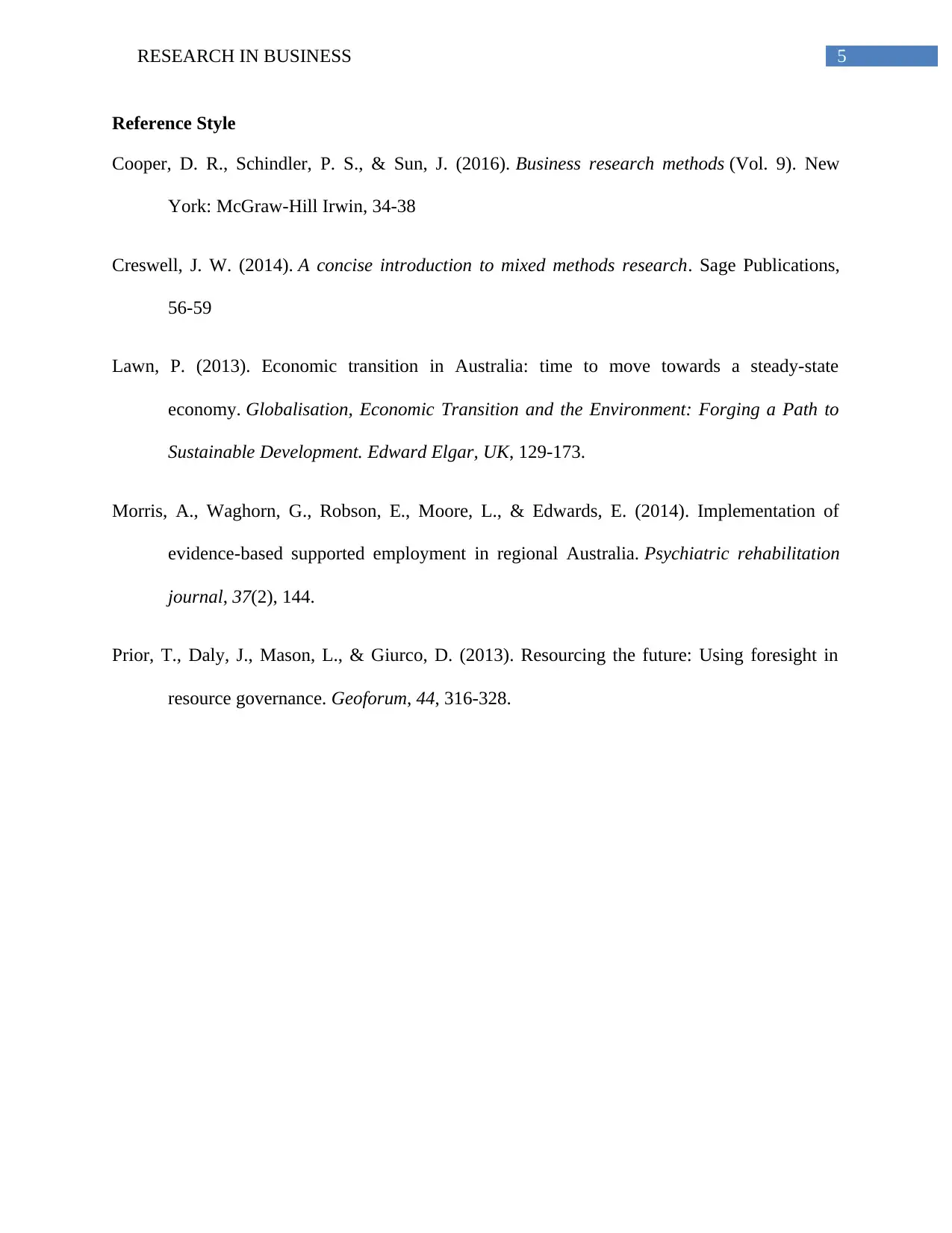
5RESEARCH IN BUSINESS
Reference Style
Cooper, D. R., Schindler, P. S., & Sun, J. (2016). Business research methods (Vol. 9). New
York: McGraw-Hill Irwin, 34-38
Creswell, J. W. (2014). A concise introduction to mixed methods research. Sage Publications,
56-59
Lawn, P. (2013). Economic transition in Australia: time to move towards a steady-state
economy. Globalisation, Economic Transition and the Environment: Forging a Path to
Sustainable Development. Edward Elgar, UK, 129-173.
Morris, A., Waghorn, G., Robson, E., Moore, L., & Edwards, E. (2014). Implementation of
evidence-based supported employment in regional Australia. Psychiatric rehabilitation
journal, 37(2), 144.
Prior, T., Daly, J., Mason, L., & Giurco, D. (2013). Resourcing the future: Using foresight in
resource governance. Geoforum, 44, 316-328.
Reference Style
Cooper, D. R., Schindler, P. S., & Sun, J. (2016). Business research methods (Vol. 9). New
York: McGraw-Hill Irwin, 34-38
Creswell, J. W. (2014). A concise introduction to mixed methods research. Sage Publications,
56-59
Lawn, P. (2013). Economic transition in Australia: time to move towards a steady-state
economy. Globalisation, Economic Transition and the Environment: Forging a Path to
Sustainable Development. Edward Elgar, UK, 129-173.
Morris, A., Waghorn, G., Robson, E., Moore, L., & Edwards, E. (2014). Implementation of
evidence-based supported employment in regional Australia. Psychiatric rehabilitation
journal, 37(2), 144.
Prior, T., Daly, J., Mason, L., & Giurco, D. (2013). Resourcing the future: Using foresight in
resource governance. Geoforum, 44, 316-328.
⊘ This is a preview!⊘
Do you want full access?
Subscribe today to unlock all pages.

Trusted by 1+ million students worldwide
1 out of 6
Related Documents
Your All-in-One AI-Powered Toolkit for Academic Success.
+13062052269
info@desklib.com
Available 24*7 on WhatsApp / Email
![[object Object]](/_next/static/media/star-bottom.7253800d.svg)
Unlock your academic potential
Copyright © 2020–2025 A2Z Services. All Rights Reserved. Developed and managed by ZUCOL.





